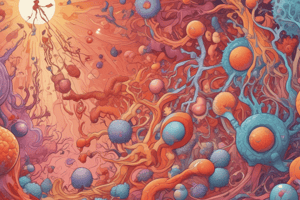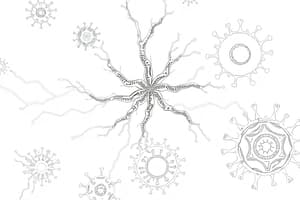Podcast
Questions and Answers
Flashcards
Local effects of inflammation
Local effects of inflammation
Redness, warmth, swelling, and pain occur due to increased blood flow and vasodilation.
Glucocorticoids effects
Glucocorticoids effects
Prolonged use can lead to lymphoid tissue atrophy and decreased protein synthesis.
Ice application to injuries
Ice application to injuries
Applying ice reduces edema through local vasoconstriction.
Healing large skin loss
Healing large skin loss
Signup and view all the flashcards
Prostaglandins function
Prostaglandins function
Signup and view all the flashcards
Neutrophils and inflammation
Neutrophils and inflammation
Signup and view all the flashcards
Abscess contents
Abscess contents
Signup and view all the flashcards
Interferons
Interferons
Signup and view all the flashcards
Causes of inflammation
Causes of inflammation
Signup and view all the flashcards
Capillary net hydrostatic pressure
Capillary net hydrostatic pressure
Signup and view all the flashcards
Cardinal signs of inflammation
Cardinal signs of inflammation
Signup and view all the flashcards
Anti-inflammatory drugs
Anti-inflammatory drugs
Signup and view all the flashcards
Reye’s syndrome risk
Reye’s syndrome risk
Signup and view all the flashcards
Systemic manifestations of inflammation
Systemic manifestations of inflammation
Signup and view all the flashcards
Phagocytosis
Phagocytosis
Signup and view all the flashcards
Inflammatory chemical mediators
Inflammatory chemical mediators
Signup and view all the flashcards
Scar tissue complications
Scar tissue complications
Signup and view all the flashcards
Wound healing process
Wound healing process
Signup and view all the flashcards
Healing promotion factors
Healing promotion factors
Signup and view all the flashcards
Burn severity factors
Burn severity factors
Signup and view all the flashcards
Emergency burn care
Emergency burn care
Signup and view all the flashcards
Carbon monoxide threat in burns
Carbon monoxide threat in burns
Signup and view all the flashcards
Hypermetabolism with burns
Hypermetabolism with burns
Signup and view all the flashcards
Scar tissue obstructions
Scar tissue obstructions
Signup and view all the flashcards
COX-2 inhibitors risk
COX-2 inhibitors risk
Signup and view all the flashcards
Spices lacking anti-inflammatory action
Spices lacking anti-inflammatory action
Signup and view all the flashcards
Cytokines source
Cytokines source
Signup and view all the flashcards
Eosinophils in allergy
Eosinophils in allergy
Signup and view all the flashcards
C-reactive protein appearance
C-reactive protein appearance
Signup and view all the flashcards
Study Notes
Inflammatory Response
- Some local effects of inflammation include redness, warmth, and swelling.
- Prolonged glucocorticoid use can cause atrophy of lymphoid tissue, increased infection resistance, and decreased protein synthesis.
- Applying ice to an injury causes reduced edema by promoting vasoconstriction.
- Healing of extensive skin loss is most successful through the use of biosynthetic skin substitutes.
- Prostaglandins are produced from activated plasma proteins and increase capillary permeability.
- Neutrophils increase significantly in the blood during inflammation.
Inflammatory Response (continued)
- Abscesses contain purulent exudate.
- Nonspecific agents that protect cells from viruses are called interferons.
- Causes of inflammation include physical damage, allergic reactions, and infection.
- The net hydrostatic pressure in capillary exchange is based on the difference in hydrostatic pressures between capillaries and interstitial fluid.
- Cardinal signs of inflammation, excluding nausea, include redness, loss of function, and swelling.
Inflammatory Response (continued)
- Drugs with anti-inflammatory, analgesic, and antipyretic properties include COX-2 inhibitors (NSAIDs), glucocorticoids, ibuprofen, and acetaminophen.
- Aspirin (ASA) is discouraged in children with viral infections due to the risk of Reye's syndrome
- Systemic manifestations of inflammation include pyrexia (fever), malaise, and anorexia, but not local swelling.
- Phagocytosis is a crucial aspect of inflammation, performed by macrophages.
Healing and Inflammation
- Resolution occurs when minimal tissue damage allows for cell recovery.
- Regeneration involves the replacement of damaged cells by similar cells capable of mitosis.
- Granulation tissue forms a temporary fix for damaged tissue and not a permanent replacement.
- Scar tissue replaces damaged cells that are unable to mitosis.
- Incorrect statement: Inflammation caused by an allergen, burn, infection is a serous exudate, disorders with inflammation do not end in "-sarcoma".
- Inflammation helps localize/isolate foreign material with fibrinogen.
- Cold application reduces inflammation immediately following injury causes vasoconstriction.
Wound Healing and Burns
- Applying cold to a wound reduces inflammation by causing local vasoconstriction following injury.
- Tissue engineering research aims to create functional replacements for damaged tissue when regeneration isn't possible
- Causes of extensive burns are due to the high temperature, duration, and extent of the exposure.
- Inhalation-related injuries from burns include carbon monoxide absorption preventing sufficient oxygen uptake.
- Hypermetabolism, increased heat loss, recurrent stress response are all contributors to stress in burn victims.
- Scar tissue can cause obstructions by attaching to nearby normal tissue and shrinking over time.
Inflammation and Chemical Mediators
- Cytokines are chemical mediators that are released by macrophages.
- A substance not normally found in the blood, appearing in acute inflammation/necrosis, is C-reactive protein.
- Eosinophils are increased during allergic responses.
- COX-2 inhibitors are associated with an increased risk of heart attack.
Studying That Suits You
Use AI to generate personalized quizzes and flashcards to suit your learning preferences.



